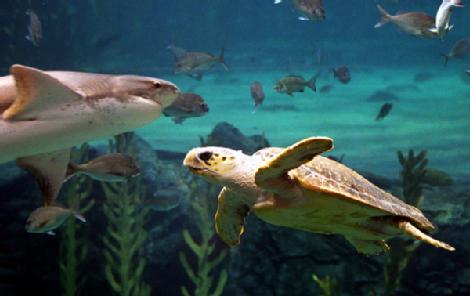
Just like in the movie Finding Nemo, Australia's young loggerhead turtles make this 20,000-kilometre voyage by riding the ocean currents, new research shows.
Turtle researcher Michelle Boyle said that soon after the little loggerheads hatch on the Queensland coast they head for the water.
Only five centimetres long, they go into a swimming frenzy, she said. "They swim pretty much non-stop for 24 hours like little clock-work wind-up animals so they can get out to the offshore currents."
The diminutive "dudes" then take an ocean superhighway south - the East Australian Current to Sydney.
After that, reality differs from fiction. "In the movie the turtles stayed around Sydney, whereas ours continue on," said Dr Boyle, who carried out her study while at James Cook University.
They appear to head eastwards into the Tasman Front which takes them past Lord Howe Island, north of New Zealand and across the southern Pacific.
A strong current off the coast of South America then sweeps them north past Chile to Peru, where some of the turtles, now about 55 centimetres long, get caught in long-line fishing nets.
Dr Boyle and her colleagues were able to track the mysterious turtles' migration for the first time by comparing DNA from nesting females in Queensland, little ones stranded on south-eastern Australian beaches, and those caught near Peru. It was found that they all shared the same genetic background, and the results are published in the journal Proceedings Of The Royal Society B.
Many questions still have to be answered, such as whether the turtles swim in the currents or just lie back and enjoy the ride.
"We also wonder how long they spend over there, on the other side of the ocean," Dr Boyle said.
Until satellite tracking is done, it can only be assumed they use the South Equatorial Current to get back to the Queensland coast.
When they reappear they are about 70 centimetres long, but there is no accurate way to determine the age of turtles. "So we don't know how long they have been away," said Dr Boyle, who estimates they are 10 to 15 years old.
Loggerhead turtles do not reach sexual maturity until 30.
The ocean currents provide a rich source of food, such as algae and molluscs, but they also concentrate plastic waste.
Many of the stranded turtles have consumed plastic.
"We can't prove that is what is killing them, but it is not helping them," Dr Boyle said.
During the past 30 years the number of loggerheads nesting each year in eastern Australia has dropped by 86 per cent.
But Dr Boyle said better protection of their habitats and the compulsory use of devices on trawl nets in Queensland waters to prevent the turtles being caught had begun to have a beneficial effect.



Reader Comments
to our Newsletter